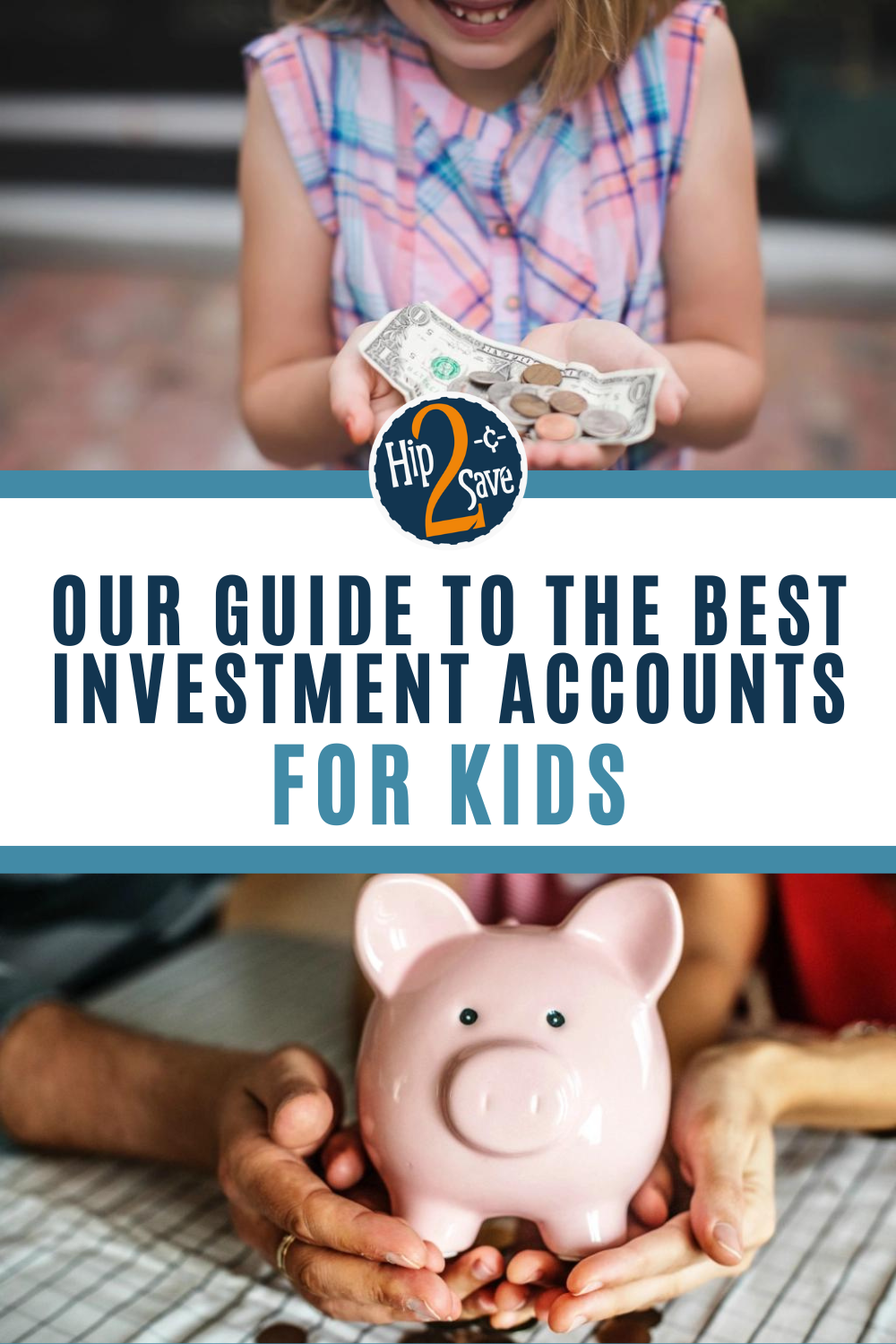Our Guide To The Best Investment Accounts For Kids
It’s never to early to start investing for kids! Get your child’s savings started with one of these top investment accounts for kids!

Save for the future with these top investment accounts for kids.
Those eighteen years go by faster than you know it! When your child is ready to fly the nest, you’ll want them to have the resources they need to be successfully independent.
Many parents worry about having sufficient savings to get their child started in life. Fortunately, there are several investment accounts for kids. Starting one of these accounts is a great way for moms and dads to example good personal finance plus doing so comes with a lot of benefits. Not only will your child make money in interest, but they’ll learn money management and possibly reduce their need for student loans.
If you’re ready to start investing for kids but are not familiar with your options, you’ve come to the right place. We put together this helpful guide that can assist you in picking out the best investment account for your kids. We’ve even included a FREE cheat sheet printable to help you compare accounts quickly! Choose one type of account or choose a few!
Whether you have a baby on the way or are raising a couple of teenagers, here is the information you need to know to start saving!
7 Best Investment Accounts for Kids:
1. Custodial Roth IRAs for kids are easy to open and can teach your teens about personal finance.

A custodial account refers to a savings account that is set up for the benefit of a beneficiary (your minor child) but administered by a custodian (their parent or legal guardian). There are a few types of these accounts available to children and one of them is a custodial Roth IRA (an Individual Retirement Account).
These accounts are easy to open. They are for minor children who are older and bring in some sort of part-time income. This could be a job with a W-2 or even something like babysitting. With this type of account, your child can contribute after-tax dollars towards retirement. These funds will grow over time and your child will never need to pay tax (or penalties) on them again so long as they follow withdrawal guidelines!
After 5 years, the child can withdraw contributions tax-free and even withdraw for a major life event like buying a home or acquiring an education. As custodian, you’ll be in charge of maintaining the account until your child reaches a certain age, somewhere between 18 and 25. At this point in time, the account will be the sole responsibility of your child.
The caveat with these accounts is that there is a cap on how much your child can contribute annually. They can only contribute the amount they earned in a given year and there is a current annual maximum of $6,500 (varies by year).
Also, if you would like to let your child keep their wages and make the contribution for them, you can do so. However, you may only contribute an amount equal to or less than what the child earned that year.
Whatever money the parent contributes to a child’s Roth IRA is subject to gift tax rules. If you want to contribute tax-free, make sure to stay under the annual limit for monetary gifts when contributing to accounts in your child’s name. In 2023, any contributions to your child over $17,000 per individual (or over $34,000 per couple) are taxable.
Where to get a Roth IRA’s for a minor:
2. Custodial UGMA and UTMA trust accounts offer the most flexibility.

Parents control these custodial trust accounts until their minor child reaches a certain age – this varies by state but is usually between 18 and 21 years. One advantage of these accounts is that, as of 2023, parents and other family members can contribute up to $17,000 annually per person (or $34,000 per married couple) without incurring a gift tax. Unlike a ROTH IRA, contributions are not limited to being equal to what the child earned that year.
Another advantage of these trust accounts is that once the child is an adult, they can use the funds as they see fit. This offers flexibility that some other types of investment accounts for kids do not, like the 529 Education Savings Plan (see #4) which cover only education costs.
A Uniform Gifts to Minors Account (UGMA) is available in all 50 states. This type of account can only hold financial assets like cash, stocks, bonds, mutual funds, and exchange traded funds EFTs.
A Uniform Transfer to Minors Account (UTMA) is currently available in 48 states (not in Vermont or South Carolina). In addition to financial assets, this type of account can also hold property like jewelry, cars, and houses.
One disadvantage of these accounts is that they may impact your child’s eligibility for financial aid. Once your child is an adult, they are the sole owner of the assets inside the trust (this transfer is irrevocable so don’t add anything to these accounts you want back). Many colleges expect a student to pay 20% of their assets towards education expenses and that will include what is being held in the trust. Speak to your financial advisor if you have concerns.
Some places to get a UGMA or UTMA account:
- Acorns Early (has a highly-rated investing app for kids)
- EarlyBird (has a highly-rated investing app for kids)
- Fidelity
- Charles Schwab
- PNC Bank
- Ally Bank
- Vanguard
3. Grow your teen’s investing skills with a Fidelity Youth Account.

Traditional brokerage accounts are another option for saving that allows your kiddo to benefit from compound interest. You obtain these taxable accounts through a broker. The accounts can hold cash or other financial assets like stocks and mutual funds. Some may even provide you a debit card, though others may not. You can open a traditional individual account in your name or a standard joint account with your minor child (of any age) and share ownership of the assets. Brokerages like Vanguard and Charles Schwab offers these accounts.
If you have a teenager, you can give them even more independence by helping them open a Fidelity Youth Account (for ages 13 to 17). It’s one of the top-rated investment accounts for kids in 2023. A Fidelity Youth Account gives your teen sole ownership of the account and only they are allowed to make withdrawals. Don’t worry, parents can still monitor their child’s activity like their monthly statements, debit transactions, and trade confirmations!
The Fidelity Youth Accounts also come with an investing app for kids so they have access to their account at their fingertips. They can even invest in stocks for as little as $1, making these accounts one of the best ways to help your teen grow invaluable investing skills. Some other perks of a Youth Account are that it has no monthly fees, no account minimums, no domestic ATM withdrawal fees, and can be linked with your teen’s PayPal or Venmo. When it comes to investing for kids, this account is hard to beat!
Hip Tip: For a limited-time only, your teen will receive a $50 reward when they download the Fidelity investing app for kids and activate their Youth Account. Sign up for an account today!
4. Investing for kids? Save for higher education with a 529 Savings Plan.

A 529 Plan is a state-sponsored plan that helps you save for college tuition. Similar to a Roth IRA, these are tax-advantaged plans that allow you to contribute post-tax dollars and allow them to grow without needing to pay taxes again.
There is no minimum to open these accounts. You can also contribute as much as you’d like, just keep in mind that contributions greater than $17,000 (or $34,000 per married couple) are subject to gift tax. 529s may also be subject to management fees so read the fine print when deciding where to open your plan.
As for the 529 plan you can get, there are two types. The most common is the 529 Education Savings Plan. With this type of plan you can make contributions and invest money in the market. Withdrawals can be made tax-free for educational purposes. These funds can go towards college, and thanks to policy reform, up to $10,000 can go towards approved K-12 and graduate school expenses, also.
The second type of 529 is a prepaid tuition plan. This type of plan allows you to pay for college credits in advance at today’s prices which is pretty neat! Paying this way can help you to avoid any student debt later. However, to lock in the price, your child will need to go to a participating school. These are usually state universities and community colleges.
The disadvantage of 529 accounts is that if you make a withdrawal made for non-educational purposes you will be charged tax and you may also face penalties. The guidelines vary by state and some states may be more stringent than others. Also, the amount you save may impact the amount of financial aid your kiddo can receive.
It’s worth noting that if your child decides to not attend college, most 529 plans allow you to change the beneficiary. Also, if your child attends school in a different state than where you opened the 529, you should be able to transfer your plan.
Where to enroll in a 529 Plan:
- Through a state website (plans may vary by state so make sure to do a comparison)
- Fidelity
- Vanguard
- Charles Schwab
- Wells Fargo
Hip2Save’s Lina recommends starting a 529 Education Savings Plan as early as possible:
“We started at 529 Education Savings Plan in our state for each of our kids when they were younger, about age 10. The main benefit is you can set aside money for education and it grows tax free. If one kid opts out of college you can transfer it. Also it can be a trade school or anything related to education.
We wished would have started it when they were babies as time is your friend in this scenario. As they get older you need to make much larger deposits to catch up.”
5. A Coverdell Education Savings Account lets you pick your investments.

The Coverdell Education Savings Account (ESA) is very similar to a 529 plan. The intent of the account is to help a minor save money for school. Contributions are not tax-deductible, but distributions are tax-free provided they are used for educational purposes (if not, you face taxes and penalties). The Coverdell does have some unique benefits that the 529 does not, so we still think it is worth making the list.
One advantage of the Coverdell ESA over the 529 Plan is that you can pick your investments. If you see a stock you’d love to invest in, you have that choice, and you can even invest in alternative assets like real estate! To compare, a 529 Plan typically gives you less control in that area and there is a much smaller investment selection.
Another advantage of the Coverdell ESA is that you can open one at many institutions, like credit unions and banks, instead of just through the state or a brokerage like you do with a 529. You can also use your funds for K-12 expenses (the 529 has a $10,000 cap).
The big disadvantage of a Coverdell account is that there is a very low annual cap on your contributions. That cap is just $2,000. Remember, the lower your contributions, the less compound interest you’ll make, so this cap does impact your earning ability. Also, unless the beneficiary has special needs, they must withdraw the funds by age 30 to avoid taxes.
Another disadvantage is that the amount of financial aid your child is eligible to receive may be impacted by the balance in your Coverdell account. Lastly, to open a Coverdell, households must make under a certain amount of money. Single parent households must have an adjusted gross income (AGI) of $95,000 and married couples must have an AGI of $190,000.
It is possible to use a Coverdell ESA and a 529 Plan in tandem, so that is something to consider if you like the benefits of both accounts.
Suggested places to open a Coverdell ESA:
6. Certificate of Deposits are low-risk and simple to open.

Another option when it comes to investment accounts for kids is to open a Certificate of Deposit (CD). These are low-risk investments that are FDIC insured. Basically, you give your bank money for a specified period of time and when the CD expires, the bank pays you back with interest. At the time you open a CD, you are guaranteed the return rate and the interest rates on CDs are higher than a traditional savings account which is why many people invest in them.
The disadvantage of a CD is that you must commit to the term limits or face penalties. Another disadvantage is that if you only deposit a small amount, you’ll only make a small amount in return. For this reason, it is probably best to use a CD in conjunction with another savings strategy like a 529 Plan or UGMA.
The going interest rate for CDs changes regularly and so do the minimum deposit amounts and term rates. Always shop around for the best rate. A simple Google search will bring up several options for you and Bankrate often updates their website with the best deals for the month.
At the time of this article, the best places to get a CD are:
- Byline Bank: 5.25% APY on an 11-month CD with a minimum $5,000 deposit
- Huntington Bank: 5.18% APY on an 11-month CD with a minimum $1,000 deposit
- Alliant Credit Union: 5.15% APY on a 18-month CD with a minimum deposit of $1,000
- Marcus by Goldman Sachs: 5.05% APY on a 10-month CD with a minimum $500 deposit
- Synchrony Bank: 5.00% APY on a 6-month CD with no minimum deposit
- Barclays Online Banking: 4.90% APY on a 12-month CD with no minimum deposit
7. Have a child with special needs? An ABLE account can help you save for disability expenses without impacting their Medicaid or SSI eligibility.

If you have a disabled child, consider opening an Attainable Savings Plan, sometimes called an ABLE account. These accounts are named after the Achieving a Better Life Experience (ABLE) Act which took place in 2014 to give those who are disabled the ability to properly save for their needs.
ABLE accounts are tax-advantaged and do not impact your child’s eligibility for Medicaid. It also usually will not impact their Supplemental Security Income (SSI), though those with over $100,000 in an account should review the SSI guidelines. Contributions to an ABLE account may be taxed, but your child will not pay taxes on their account earnings or distributions.
There is a cap on how much one can contribute to an ABLE account each year. In 2023, the cap is $17,000 annually. If you would like to contribute more, consider opening an Supplemental Needs Trust (SNT) in addition to or in place of an ABLE account. SNTs are similar to ABLE accounts but have no contribution limit. SNTs have more restrictions on what withdrawals can be used towards, so keep that in mind.
With an ABLE account, distributions can be used for expenses like education, housing, transportation, training and support, employment, personal support services, health expenses, basic living expenses, assistive technologies, and other disability expenses that improve quality of life.
Places to get an ABLE account:
- Fidelity Attainable Savings Plan
- Through a state program (does not have to be your state)
One investment account to consider skipping…
You may have heard of the Gerber Life College Plan when discussing saving for college. According to the websites Saving for College and Value Penguin, your return on investment will be almost half that of a 529 Savings Plan. In fact, the interest on a Gerber Life College Plan is even lower than a long-term bank CD, so we suggest looking into one of the other options on the list first!







So I’m looking for a way to start building my 16 year olds credit. I called the local bank, but the only thing they have is a credit card when she turns 18. Does anyone have any suggestions?
You should be able to add your child as a secondary user on your own credit card. This will help them establish credit without opening up their own account.
Thanks so much for the helpful response, haylorsmermaid! 🤗💗
That’s what I am going to be doing for my Little. Just make sure you have good credit.
Hey there MelissaB! You might check this post to see if the Greenlight debit card is an option for your teen! There may be a minimum legal age for many credit opportunities, but you can also check with your financial institutions on possibly adding her as an authorized user to an existing account as well. Hoping these suggestions are helpful! 💞
Ok thank you!!!
So what happens if you add your child as secondary user and you pass away? As I understand it I am primary on my credit card and my husband is named on my account,, however if I pass away he is no longer eligible to use that card
Great question, Deborah! I would check with your card issuer on that, because it could vary, but in my experience the authorized user would no longer be able to use the credit card if the primary owner of the account is deceased. 🤗 ❤️
There is a new law that allows unused 529 funds to be converted into a Roth IRA for the child! There are some specific rules (15 year seasoning of the 529 account, $35k Max, convert over a few years as it is subject to the annual roth contribution limits). But it’s a amazing opportunity to save for college and start saving funds for a future Roth IRA account.
Thanks for mentioning that, Bre. Good to know. 🙌❤️